Abstract
With the increasing service life of asphalt pavements, fatigue cracking has become a typical distress that significantly affects the structural lifespan of in-service asphalt pavements. To address the issues of high variability in laboratory fatigue tests and the poor correlation between test results and actual pavement cracking conditions, this study collected field core samples from in-service highways with varying degrees of cracking. The study employed push-pull fatigue tests on asphalt mixtures and linear amplitude sweep tests on extracted and recovered asphalt to evaluate fatigue performance. Quantitative relationships between transverse crack spacing and fatigue indices were established. With the inclusion of laboratory-compacted asphalt mixtures, the relationship between transverse crack spacing and the average pseudo-stiffness degradation rates was well described by a logarithmic function (R2 = 0.928), while the apparent damage capacity achieved a stronger correlation (R2 = 0.945). The findings demonstrate that the push-pull fatigue test, based on a viscoelastic continuum damage model, shows high stability and repeatability, with the coefficients of variation for the indices consistently below 11%. Compared to the average pseudo-stiffness degradation rates, the apparent damage capacity demonstrates better discriminative capability as an evaluation index for the intermediate-temperature fatigue performance of asphalt mixtures. The fatigue life from linear amplitude sweep tests on extracted and recovered asphalt from core samples shows a high degree of consistency with the patterns observed in various parameters of push-pull fatigue tests. The findings confirm the reliability of the push-pull fatigue test for evaluating intermediate-temperature fatigue performance of asphalt mixtures and provide the necessary theoretical support for establishing a fatigue performance evaluation system for in-service asphalt pavements.
1. Introduction
During long-term service, asphalt pavements develop various distresses, among which cracking severely compromises the structural integrity and functional performance of the pavement. This often necessitates frequent medium-to-large-scale maintenance activities, resulting in significant waste of non-renewable resources [1]. Asphalt pavement cracks are generally classified into bottom-up cracks and top-down cracks. It is widely recognized in the academic community that top-down cracks are primarily caused by fatigue failure under intermediate-temperature conditions induced by cyclic vehicular loading [2,3,4,5]. In China, the design service life of high-grade asphalt pavements is typically 15 years. Considering both service duration and the cumulative axle load applications, a large number of in-service highway asphalt pavements have reached or are nearing the end of their design life. Consequently, the risk of top-down fatigue failure in the asphalt top layer has increased.
To address the issue of fatigue cracking in asphalt pavement mixtures, various laboratory evaluation methods have been proposed, including the four-point bending fatigue test, semicircular bending fatigue test, indirect tensile fatigue test, and uniaxial push-pull fatigue test [6,7,8,9,10]. Among these, the four-point bending fatigue test is recommended in the Chinese specifications for asphalt and asphalt mixture testing as a method for estimating the fatigue life of asphalt mixtures. However, obtaining standard beam specimens from in-service pavements is extremely challenging and can potentially damage the pavement structure. Additionally, the results of this test are influenced by loading mode, temperature, and frequency, making it difficult to accurately reflect actual fatigue cracking conditions. As a result, the application of the four-point bending fatigue test in evaluating the fatigue performance of in situ asphalt mixtures remains controversial. In contrast, the semicircular bending and indirect tensile fatigue tests are widely used for evaluating the fatigue performance of in-service pavements due to the ease of specimen preparation and the simplicity of the required equipment [11,12,13,14,15]. However, these methods have limitations in mechanical analysis, as fatigue performance predictions primarily rely on phenomenological empirical models. Therefore, there is an urgent need for an evaluation method that is based on a clear mechanical model and can accurately reflect the actual service conditions.
To this end, researchers have developed a fatigue performance analysis method based on the Viscoelastic Continuum Damage Model (VECDM). Using uniaxial testing modes for asphalt mixtures, the VECD model quantifies fatigue damage during testing by employing the elastic-viscoelastic correspondence principle and Schapery’s work potential theory, effectively eliminating the influence of the viscous components of the material [16,17]. Researchers have also proposed a simplified VECD model (S-VECDM) to evaluate the fatigue damage characteristics of asphalt mixtures under various loading conditions [18], and its predictive capabilities under different stress modes and strain levels have been validated [19]. The model analyzes the impact of damage accumulation at the microscopic scale on overall performance based on macroscopic observations, providing a more comprehensive approach to fatigue damage analysis. As a result, it has become one of the most advanced fatigue analysis methods.
As a crucial component of asphalt mixtures, asphalt binder provides adhesion and the necessary strength to resist traffic loads [20,21]. However, under prolonged loading, damage accumulation in the binder leads to a reduction in the modulus and strength of the mixture, ultimately shortening its fatigue life [22,23]. The Superpave specification evaluates the fatigue resistance of asphalt binders using the fatigue cracking factor G∗sinδ, a linear viscoelastic parameter. However, this approach struggles to capture the actual damage resistance in the nonlinear viscoelastic region. To address this, Bahia et al. [24] proposed the Time Sweep (TS) test, which uses a dynamic shear rheometer (DSR) to apply repeated cyclic loading of fixed amplitude to asphalt binders for fatigue damage evaluation. However, this method is time-consuming and yields results that are often difficult to reproduce. To improve efficiency, Bahia et al. [25] further developed the Linear Amplitude Sweep (LAS) test, which applies cyclic loading with linearly increasing strain amplitude at a fixed frequency to assess the fatigue performance of asphalt binders. The LAS test is more efficient than traditional methods and, when combined with the VECD model, provides a more accurate representation of fatigue damage. Studies based on LAS testing have shown that increased aging significantly reduces the fatigue life of asphalt binders [26], while the dosage of warm-mix additives has a notable impact on fatigue performance [27]. Zhang et al. [28] proposed three new indicators based on LAS testing—strain tolerance, strain energy tolerance, and the average decay rate of integrity at failure—which exhibit stronger correlations with actual pavement fatigue performance compared to traditional fatigue performance parameters. Since fatigue cracks primarily originate and propagate within the asphalt binder phase, the VECD approach to studying the relationship between binder and mixture performance can better clarify the mechanisms of fatigue failure [29,30]. Based on the research discussed above, the LAS test results for asphalt binders can be used to validate the effectiveness of push-pull fatigue tests for evaluating the fatigue performance of asphalt mixtures.
This study focuses on sections of in-service highway asphalt pavements with significant differences in fatigue cracking distress to characterize the fatigue performance under real service conditions. The push-pull fatigue test data were modeled using the viscoelastic continuum damage (VECD) model to investigate the quantitative relationships between the average pseudo-stiffness degradation rates (DR) and the apparent damage capacity (Sapp) indices with asphalt pavement crack spacing. Additionally, the LAS tests on asphalt extracted from core samples were used to validate the trends observed in the push-pull fatigue tests. From a material performance perspective, this research deepens the understanding of fatigue cracking mechanisms in existing asphalt pavements. It provides valuable references for the development and innovation of maintenance technologies aimed at extending the service life and ensuring the long-term durability of asphalt pavements.
2. Materials and Methods
2.1. Field Core Sampling
Core samples were taken from the asphalt pavement of highways in Jiangsu Province, where significant variations in crack spacing between different sections were observed. The core sampling locations were chosen from the wheel path areas of the intact driving lanes, with four cores taken from each section, spaced 25 m apart. The core sampling information is shown in Table 1. Additionally, laboratory-prepared fresh asphalt mixtures were used for experimental analysis as the initial state for material performance development, labeled as the “lab-compacted group” in Table 1.

Table 1.
Information on field coring sections.
Figure 1 illustrates the core sampling process and typical core samples. All sections feature an asphalt mixture layer with a semi-rigid base course structure. The height of the asphalt mixture layer in the cylindrical core samples ranges from 170 to 180 mm (top layer: 40 mm, middle layer: 60 mm, bottom layer: 70–80 mm), with a diameter of 150 mm. The grading type of the top layer mixture is either AC-13 or SMA-13, both using PG70-22 SBS-modified asphalt.
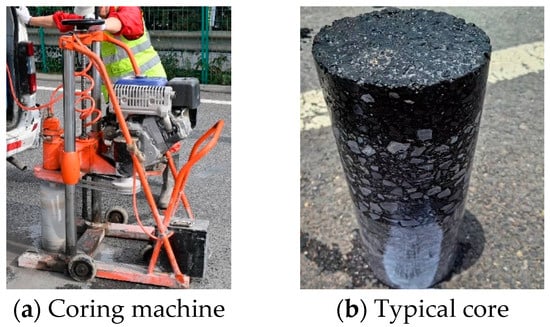
Figure 1.
Field coring procedure and typical cores.
2.2. Specimen Preparation
This study performed dynamic modulus and push-pull fatigue tests on the top layer asphalt mixture of the core samples. Given the limited thickness of the top layer in the pavement, scaled-down specimens were prepared. Previous studies have shown that small cylindrical scaled specimens with a diameter of 38 mm and a height of 110 mm exhibit similar damage characteristic curves to full-sized specimens, effectively representing the fatigue performance of the pavement core samples [31,32]. This study adopted this size and selected two core samples from each section, drilling a total of four cylindrical specimens for parallel testing. The specific preparation process for the specimens is shown in Figure 2.
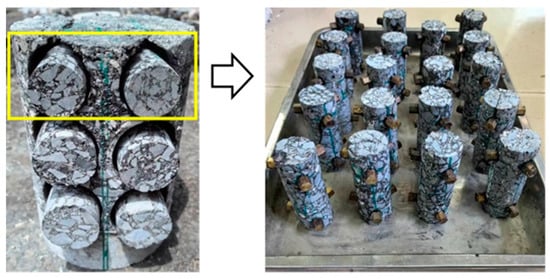
Figure 2.
Preparation of scaled-down specimens of asphalt mixtures from field cores.
The fresh asphalt mixtures used as the lab-compacted group were prepared using a gyratory compactor, with mixture types selected to match those of the actual sections, namely AC-13 and SMA-13, with binder content of 5.1% and 5.8%, respectively. The asphalt used was freshly prepared SBS-modified asphalt that had undergone short-term aging, with specific technical parameters provided in the following section. To ensure that the gradation of the lab-compacted group mixtures was consistent with the field core samples, the grading curves of the two types of lab fresh mixtures were determined based on the pavement construction data. Figure 3 illustrates the gradation curves of the two laboratory-compacted mixtures. The gradation curves of AC-13 and SMA-13 reveal key differences, with SMA-13 containing higher amounts of coarse aggregate and mineral filler. In contrast, AC-13 features more fine aggregate and a smoother gradation. Finally, twenty-eight scaled cylindrical specimens were used for push-pull fatigue tests, consisting of four specimens per highway section and the laboratory-compacted samples.
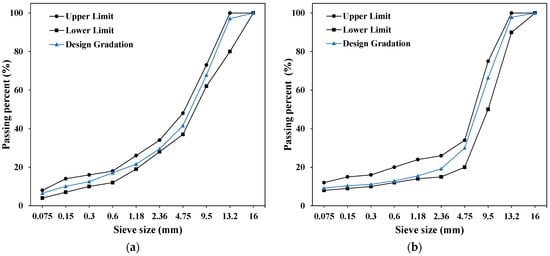
Figure 3.
Design gradation of asphalt mixtures: (a) AC-13; (b) SMA-13.
As shown in Figure 4, the asphalt binder from the top layer of the core samples was extracted and recovered using a Swiss Buchi R215 rotary evaporator, with trichloroethylene as the solvent. After allowing the solution containing trichloroethylene and asphalt to settle for 24 h, the supernatant was filtered through specially designed filter paper to remove residual mineral powder before extraction. The extracted asphalt was poured into polytetrafluoroethylene molds to produce asphalt specimens suitable for the DSR parallel plate test, with dimensions of 8 mm in diameter and 2 mm in thickness.
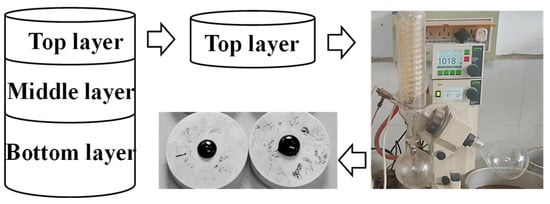
Figure 4.
Extraction and recovery of field-aged asphalt binders.
The Superpave grade of the lab-compacted group’s fresh SBS-modified asphalt was PG70-22, and its technical parameters are listed in Table 2. To simulate the aging effects during mixing and paving of asphalt mixtures, the fresh SBS-modified asphalt underwent short-term aging treatment prior to testing. Fifteen binder specimens were taken from field cores (three per section), along with three short-term aged SBS-modified asphalt specimens, totaling eighteen specimens.

Table 2.
The technical specifications of SBS-modified asphalt in the lab-compacted group.
2.3. Testing Method
Before conducting the push-pull fatigue tests, dynamic modulus tests were performed to determine the mechanical properties of the asphalt mixture within the linear viscoelastic range under intermediate temperature conditions. As shown in Figure 5a, the dynamic modulus test was carried out using the UTM-25 (Universal Testing Machine-25) system. The testing temperatures were set at 4 °C, 20 °C, and 38 °C, with sinusoidal loading frequencies of 25, 10, 5, 1, 0.5, and 0.1 Hz. During the test, the dynamic modulus and phase angle of the specimens were recorded. Two parallel specimens were tested, and the average of the results was calculated.

Figure 5.
(a) Dynamic modulus and (b) push-pull fatigue tests of asphalt mixtures.
As shown in Figure 5b, the push-pull fatigue test was conducted in strain-controlled mode, with a loading strain of 300 με and a frequency of 10 Hz. To minimize the effects of viscoplasticity, the test temperature was set at 18 °C [7,33]. During the first phase of the test, a strain of 75 με was applied for 5 s at 10 Hz within the linear viscoelastic range of the mixture to determine the initial material parameters and identify any variability among specimens within the same group. After a 20-min interval, the second phase of the test was conducted at the pre-set loading strain.
The point at which the phase angle decreased significantly during the test was defined as the failure point, and the fatigue life of the specimen was determined accordingly. The test results were analyzed using the simplified viscoelastic continuum damage (S-VECD) model [31]. A power function was used to fit the damage characteristic curve, which describes the relationship between pseudo-stiffness (C) and damage (S), as shown in Equation (1):
where C11 and C12 are the fitting parameters of the model.
Based on the damage characteristic curve, the average pseudo-stiffness degradation rate (DR) is adopted as an evaluation index, representing the average decrease in pseudo-stiffness of the asphalt mixture during loading until failure. This index is independent of temperature, loading mode, and strain amplitude, and is less affected by test variability [18], making it suitable for characterizing the fatigue performance of asphalt pavement core samples. A larger DR value indicates stronger fatigue damage resistance of the material. The calculation method is shown in Equation (2):
where C represents the pseudo-stiffness of the asphalt mixture, with an initial value of 1; n represents the number of loading cycles; Nf represents the fatigue life of the specimen, defined as the number of load cycles at failure.
Based on the DR criterion of the S-VECD model, Wang et al. [34] proposed a new fatigue parameter, the apparent damage capacity (Sapp). The primary objective is to incorporate the accumulated damage (S) within the material, simultaneously considering the effects of modulus and toughness in the evaluation of fatigue performance. When the pseudo-stiffness C equals (1 − DR), the corresponding S value on the damage characteristic curve is defined as the apparent fatigue damage resistance, i.e., Sapp. A larger Sapp value indicates stronger fatigue resistance of the material. After a semi-empirical correction related to the dynamic modulus, its calculation method is shown in Equation (3):
where Sapp is apparent damage capacity in GPa−1; αT represents the time-temperature equivalence shift factor; α is a material constant determined from the maximum slope of the relaxation modulus in a logarithmic scale; |E*| is the dynamic modulus of the material at 10 Hz and the target temperature, expressed in GPa. Additionally, a coefficient of 1/10,000 is applied to control the Sapp value within the range of 0 to 40.
The Linear Amplitude Sweep (LAS) test is used to evaluate the fatigue performance of asphalt binders under intermediate temperature conditions, with the test temperature set at 18 °C, consistent with the push-pull fatigue test for mixtures. The test employs an 8 mm spindle, with the parallel plate gap set to 2 mm. The DSR equipment and LAS testing procedure are shown in Figure 6.
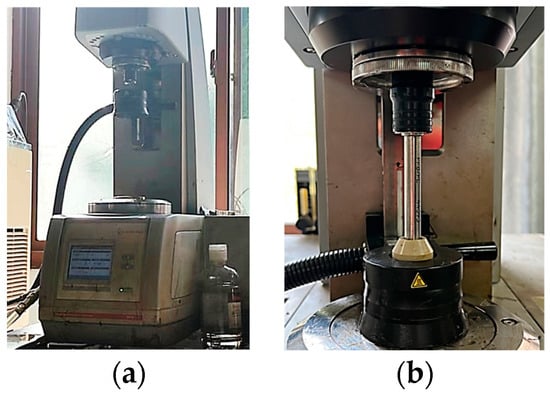
Figure 6.
(a) Anton Paar MCR 102 DSR; (b) LAS test.
The test consists of two stages. In the first stage, a frequency sweep test is conducted at 18 °C with a strain of 0.1%, and the loading frequency ranges from 0.2 Hz to 30 Hz to obtain the material properties of the asphalt binder within the linear viscoelastic region. In the second stage, a linear amplitude sweep is performed with a constant loading frequency of 10 Hz and strain control increasing linearly from 0.1% to 30%, to measure the fatigue damage resistance characteristics of the asphalt binder.
The VECD model is used to analyze the LAS test data and predict the fatigue life of the binder through a fatigue life prediction equation. The fatigue life prediction equations for asphalt binder are presented in Equations (4)–(7):
where Nf represents the fatigue life of the asphalt binder; γmax is the predicted maximum strain value of the pavement structure, which is set to 5% in this study; A and B are fatigue performance parameters; f is the loading frequency; Df is the reduction in the initial complex shear modulus under the peak shear strain; C1 and C2 are the fitting parameters of the model; αb is the characteristic parameter of asphalt in its undamaged state.
In the VECD model, the parameters A and B are typically used to evaluate the fatigue performance of asphalt binders, both being positively correlated with the fatigue resistance and modulus of the asphalt. However, parameter A is highly influenced by test variability, and parameter B struggles to capture the nonlinear behavior of asphalt. In comparison, the fatigue life Nf, derived from A and B, provides a more comprehensive and accurate assessment of the fatigue characteristics of asphalt materials [28]. Given that aged asphalt is more sensitive to stress and strain, higher strain levels are better suited to reflect its fatigue performance. Therefore, this study selects the fatigue life of asphalt sample under a 5% strain level (Nf_5%) as the parameter for evaluating fatigue performance.
3. Results and Discussion
3.1. Push-Pull Fatigue Test
The average pseudo-stiffness degradation rates (DR) for top layer core samples from each section and the two types of lab-compacted asphalt mixtures are shown in Table 3. As observed from Table 3, the DR values of top layer core samples from different sections vary significantly. The DR value of Section 5, which has the largest crack spacing, is 1.82 times higher than that of Section 1, which has the smallest crack spacing. A higher DR value indicates stronger fatigue cracking resistance of the mixture. It is evident that in sections with more severe field cracking and smaller crack spacing, the DR values are lower. This demonstrates a strong correlation between the observed cracking conditions of asphalt pavements and the fatigue resistance of the mixtures, as represented by the DR index.

Table 3.
Results of DR.
The two groups of fresh asphalt mixtures prepared in the laboratory used SBS-modified asphalt subjected to short-term aging, which can be considered representative of the performance state of asphalt mixtures after paving and compaction but before traffic loading and long-term aging. Further comparisons reveal that the DR values of the fresh asphalt mixtures are significantly higher than those of the top layer core samples. This indicates that the repeated traffic loads and aging effects experienced during long-term service significantly reduce the fatigue resistance of the field mixture, leading to fatigue cracking on the pavement surface.
To further investigate the quantitative relationship between pavement cracking conditions and the fatigue performance of asphalt mixtures, the relationship between transverse crack spacing and the DR index for each highway section was plotted in Figure 7a. The blue lines indicate the fitted curves, while the triangles represent the data points. The results show that the relationship can be well described by a logarithmic function, with an R2 value of 0.869. This quantitative relationship indicates that in sections with lower crack spacing (i.e., denser cracks), the DR index exhibits more significant variations. In other words, the DR index provides better differentiation for asphalt mixtures with poorer fatigue performance.
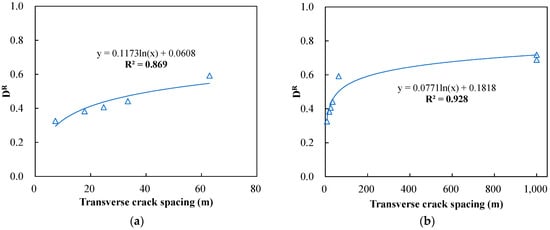
Figure 7.
Relationship between crack spacing and DR (a) excluding fresh mixes; (b) including fresh mixes.
To account for the complete service life of asphalt pavement mixtures, it is necessary to define the cracking condition of laboratory-compacted asphalt mixtures. Based on the range of the core sampling sections and the standard length of routine pavement maintenance units (1 km), this study defines the crack spacing of laboratory-compacted asphalt mixtures as 1000 m. Considering that this material represents newly paved asphalt pavements with no visible cracks (or extremely large crack spacing), this assumption is deemed reasonable.
After including the laboratory-compacted asphalt mixtures, the relationship between transverse crack spacing and the DR index was plotted in Figure 7b. The logarithmic function fit shows an improved R2 of 0.928. This indicates that the average pseudo-stiffness degradation rate (DR) obtained from the push-pull fatigue test correlates strongly with actual pavement cracking conditions. Moreover, the DR index shows potential for characterizing the fatigue performance of asphalt pavement mixtures across all service stages, starting from initial traffic opening.
Table 4 presents the apparent damage capacity (Sapp) values for the top layer cores from each highway section and the two types of lab-compacted asphalt mixtures. A higher Sapp value indicates greater fatigue resistance of the mixture. As shown in Table 4, the correlation between the Sapp values and the crack spacing across the sections generally mirrors that observed for the DR index. Except for the anomalously low Sapp value in Section 4, the Sapp values increase consistently with rising crack spacing, demonstrating a strong correlation. The lab-compacted asphalt mixtures, which have not been subjected to prolonged loading or aging, exhibit significantly higher Sapp values compared to the top layer cores from all sections, aligning with the trend observed for the DR index.

Table 4.
Results of Sapp.
Similarly, the relationship between crack spacing and the Sapp index for each highway section is plotted in Figure 8a. The blue lines indicate the fitted curves, while the squares represent the data points. The two variables exhibit a strong correlation that can be well-fitted by a logarithmic function, with R2 = 0.929. This indicates that the Sapp index is more sensitive to materials with poorer fatigue performance in terms of actual pavement cracking conditions.
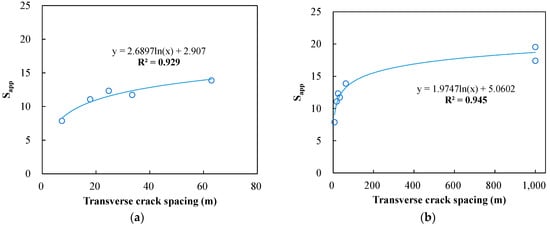
Figure 8.
Relationship between crack spacing and Sapp (a) excluding fresh mixes; (b) including fresh mixes.
Using the previously defined crack spacing for the lab-compacted asphalt mixtures (1000 m), the relationship between crack spacing and the Sapp index, including the lab-compacted mixtures, is plotted in Figure 8b. The logarithmic fit improves compared to the case excluding the lab-compacted mixtures, with R2 = 0.945. This demonstrates a clear trend in the Sapp index across different crack spacing levels for the top layer asphalt mixtures. Combined with the evaluation results of the DR index, it can be preliminarily inferred that the push-pull fatigue test effectively reflects the fatigue cracking performance of asphalt pavements under actual service conditions.
Wang et al. [34] demonstrated that the DR index primarily reflects the material’s toughness, which is closely related to its energy absorption capacity. High-toughness materials can absorb and dissipate energy more effectively, thereby delaying the formation of fatigue cracks. On the other hand, the Sapp index integrates the effects of both stiffness and toughness, simultaneously accounting for the material’s modulus and energy absorption capacity. A higher modulus alone does not necessarily guarantee longer fatigue life, nor can the DR value alone fully determine fatigue performance.
In their study, two mixtures with similar DR values but significantly different modulus values were compared: C3 (control group) and R3 (high content reclaimed asphalt pavement group, with a higher modulus). Results showed that the R3 mixture exhibited better fatigue resistance under identical loading conditions and had a higher Sapp index. Field tests also revealed that the C3 pavement had more cracks [35]. Therefore, the Sapp index, developed based on the DR index, theoretically accounts for the stiffness of the mixture while considering its toughness. This allows for further differentiation of materials’ fatigue performance in cases where DR values are similar, providing better consistency with real-world pavement performance. This conclusion was confirmed in the fitting results of the previous section, where Sapp showed a higher R2 value than DR, regardless of whether lab-compacted asphalt mixtures were included.
To further compare the sensitivity of different indices to changes in crack spacing, the variation of DR and Sapp indices with crack spacing is illustrated in Figure 9. Both indices are positively correlated with crack spacing, with the lab-compacted asphalt mixtures showing the highest values, indicating that sections with poorer fatigue resistance exhibit more severe cracking. Comparatively, the DR index changes more gradually when crack spacing is less than 30 m, but shows a steeper increase in the 30–70 m range. This suggests that in larger crack spacing ranges (greater than 30 m), the improvement in crack conditions is increasingly influenced by the toughness of the surface mixture, as high-toughness mixtures effectively increase crack spacing. Conversely, the Sapp index changes more rapidly in the 5–30 m range, reflecting that as fatigue damage progresses (with crack spacing below 30 m), Sapp is more sensitive than DR in capturing the decline in pavement performance.
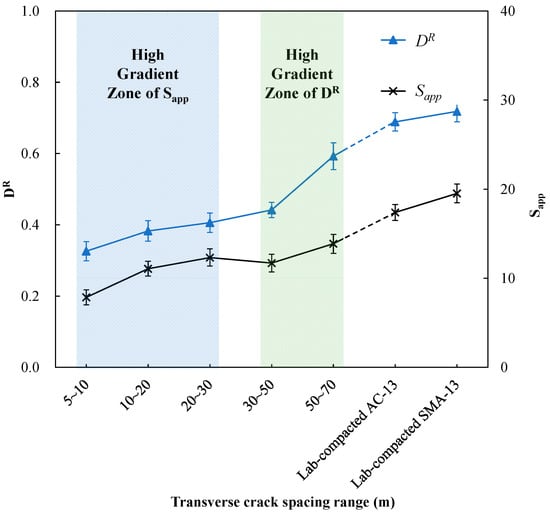
Figure 9.
Comparison of DR and Sapp.
Comparing the lab-compacted AC-13 and SMA-13 mixtures in Figure 9, it was observed that the fatigue indices of the SMA-13 mixture were higher than those of the AC-13 mixture. The superior performance of SMA-13 can be attributed to its higher content of coarse aggregates and binder, which result in a more stable skeleton structure, greater durability, and improved fatigue resistance. To further evaluate the ability of the DR and Sapp indices to distinguish the fatigue performance of the two mixtures, a comparison was made not only between the lab-compacted mixtures but also between the top layer mixtures from different locations within sections 2 and 3 of the same highways. These two sections share the same service life and traffic direction, with similar stake numbers and traffic volume. The primary distinction lies in the type of top layer mixtures used.
As shown in Table 5, both the DR and Sapp indices of the SMA-13 mixture are higher than those of the AC-13 mixture, indicating that both indices effectively reflect the differences in fatigue performance between the two mixture types, with consistent evaluation results. To further quantify the discrimination ability of these two indices, the performance index ratio of AC-13 to SMA-13 for the same set of samples was calculated (see the AC-13/SMA-13 row in Table 5). Given that SMA-13 exhibits superior durability and fatigue resistance compared to AC-13, a smaller ratio indicates that the corresponding evaluation index has a better ability to differentiate between the two types of mixtures.

Table 5.
Comparison of different types of mixtures.
The comparison reveals that the Sapp index demonstrates a stronger capacity to distinguish the fatigue performance of these mixtures. Therefore, when assessing the fatigue performance of mixtures with different gradation types, it is recommended to prioritize the Sapp index.
To compare the stability and repeatability of the DR and Sapp indices, their coefficients of variation (COV) were analyzed (as shown in Figure 10). The COV of the DR index for different road sections were all below 9%, indicating good stability of the DR index. The lab-compacted asphalt mixtures had the lowest COV, not exceeding 4%, while the field core samples exhibited higher COV. This is primarily because the top layer asphalt mixtures in the field are subject to complex factors such as environmental and traffic loads, leading to lower stability in the test results compared to lab-compacted specimens. The COV of the Sapp index for different sections were all below 11%. Similar to the DR index, the lab-compacted asphalt mixtures exhibited the lowest COV, not exceeding 6%.
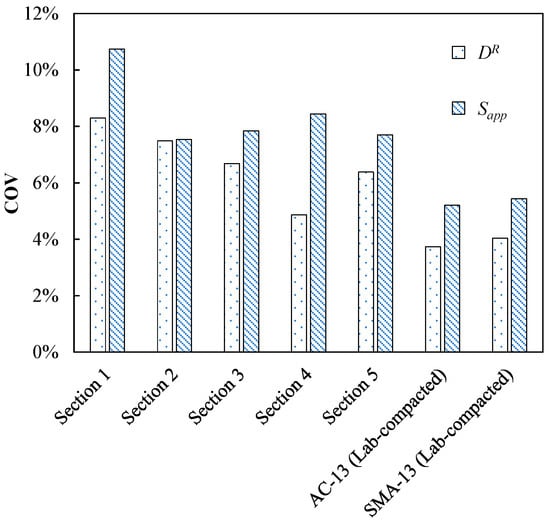
Figure 10.
Comparison of Coefficient of Variation (COV) between DR and Sapp.
A comparison of the COV of the two indices revealed that the COV of the DR index was consistently lower than that of the Sapp index for the same materials. This may be related to the definition and calculation of the Sapp index, which is influenced by multiple factors, including the DR value of the specimen, the damage characteristic curve, and the representative dynamic modulus. These combined influences contribute to the slightly higher COV of the Sapp index compared to the DR index. Overall, both the DR and Sapp indices benefit from the uniaxial tension-compression testing mode and the S-VECD model, which are unaffected by loading mode, temperature, and stress/strain amplitude. The COV of all test groups were below 11%, effectively addressing the high variability and poor repeatability of traditional fatigue evaluation methods.
3.2. Validation Using Asphalt Binder LAS Test
The LAS test was conducted on the field-aged asphalt extracted from the top layer cores of each highway section, as well as on the short-term aged SBS-modified asphalt, to evaluate the fatigue cracking resistance of the asphalt binder at intermediate temperatures. The test results are presented in Table 6.

Table 6.
Results of LAS tests.
In the LAS test, a larger Nf_5% indicates better fatigue performance of the asphalt binder at intermediate temperatures. The test results show that Section 4, with a service life exceeding 20 years, exhibits significant aging of the surface asphalt, resulting in a markedly low Nf_5%. Excluding Section 4, asphalt binders from sections with greater crack spacing demonstrate higher Nf_5%, indicating better resistance to fatigue cracking. The Nf_5% of the short-term aged SBS-modified asphalt is significantly higher than that of the asphalt binder extracted from the cores. This highlights the effects of long-term field aging, which leads to changes in the physical and chemical properties of the asphalt binder, including hardening, increased viscosity, and reduced chemical components. These changes significantly degrade its fatigue performance. Aged asphalt exhibits increased brittleness and reduced strain capacity, making it more prone to crack initiation and propagation under repeated loading.
The above analysis demonstrates that the LAS test effectively reflects the fatigue performance of asphalt pavements at intermediate temperatures, with results showing a consistent trend with the fatigue parameters from uniaxial push-pull fatigue tests. The binder test further confirms the correlation between fatigue parameters from push-pull fatigue tests and pavement cracking severity, validating its reliability in evaluating the fatigue performance of in-service asphalt mixtures.
4. Conclusions
In this study, core samples were extracted from the typical sections of in-service asphalt pavements with varying cracking conditions on multiple highways. Push-pull fatigue tests were conducted on the mixtures to verify the relationship between test indicators and actual cracking performance and to establish a correlation between mixture fatigue parameters and pavement cracking conditions. Various evaluation indicators obtained from the push-pull fatigue tests were compared from multiple perspectives, and their applicability was analyzed. Furthermore, the LAS test results of asphalt binders were used to validate the consistency of the fatigue test indicators for asphalt mixtures. The main conclusions of this study are as follows:
- The push-pull fatigue test method based on the S-VECD model provides reliable fatigue performance evaluation indicators, effectively assessing the intermediate-temperature fatigue damage characteristics of in-service asphalt mixtures. The fatigue indicators demonstrate a strong correlation with the actual cracking conditions of the pavement.
- The apparent damage capacity indicator, Sapp, accounts for both the modulus and toughness of the material, showing higher sensitivity to the fatigue performance of asphalt mixtures in heavily cracked pavement sections compared to the average pseudo-stiffness degradation rate (DR). Additionally, Sapp demonstrates superior differentiation in performance among mixtures with different gradation types. Based on extensive test results, its coefficient of variation remains below 11%, indicating good stability and repeatability.
- The top layer gradation type significantly impacts the fatigue performance of asphalt mixtures. SMA-13 mixtures, with their more stable skeleton structure and higher binder content, exhibit superior fatigue performance than AC-13, as reflected by larger pavement crack spacing. In sections with smaller crack spacing, the fatigue performance of the mixtures deteriorates significantly, indicating that high stress concentrations and frequent loading intensify pavement damage.
- The LAS test results further revealed the significant contribution of asphalt binder fatigue performance deterioration to the overall degradation of mixture performance. Across highway sections with varying cracking conditions, the fatigue life of asphalt binder demonstrated consistent trends with the fatigue parameters from mixture push-pull fatigue tests. This indicates that the decline in binder fatigue performance is the primary cause of the reduction in asphalt mixture fatigue performance, effectively validating the correlation between push-pull fatigue test results and pavement cracking severity.
This study provides scientific evidence for assessing the fatigue performance of in-service asphalt pavements and designing maintenance strategies for crack distress, thereby extending pavement life. Given the variability of field material properties and environmental conditions, future research will investigate the fatigue behavior of field asphalt mixtures and binders under different service times, environmental factors, and loading conditions, further validating the correlation between laboratory fatigue tests and field performance.
Author Contributions
Conceptualization, Z.Z. and J.J.; Formal analysis, Z.Z., Y.F., H.M. and Z.D.; Funding acquisition, J.J.; Investigation, D.X., Y.F., H.M. and Z.D.; Methodology, Z.Z. and J.J.; Resources, J.J. and J.L.; Supervision, J.J. and T.M.; Writing—original draft, D.X. and J.J.; Writing—review & editing, Z.Z. and J.J. All authors have read and agreed to the published version of the manuscript.
Funding
This work was supported by the National Natural Science Foundation of China (Grant No. 52108421), Jiangsu Science and Technology Association Youth Science and Technology Talent Lifting Project (Grant No. JSTJ-2023-017), and Scientific Research Project of Jiangsu Communications Holding Co., Ltd. (Grant No. 2023JKY07).
Institutional Review Board Statement
Not applicable.
Informed Consent Statement
Not applicable.
Data Availability Statement
All data are included in the article.
Conflicts of Interest
Authors Zhanming Zhang, Yunlong Fan, Hui Ma, Zihao Ding, and Jie Li were employed by the company Jiangsu Highway Engineering Maintenance Technology Co., Ltd. The remaining authors declare that the research was conducted in the absence of any commercial or financial relationships that could be construed as a potential conflict of interest. The authors declare that this study received funding from Jiangsu Highway Engineering Maintenance Technology Co., Ltd. The funder had the following involvement with the study: study design, collection, analysis, the writing of this article, and the decision to submit it for publication..
References
- Lyu, S.; Liu, C.; Qu, F.; Zheng, J. Test Methods and Characterization of Fatigue Performance of Asphalt Mixtures: A Review. China J. Highw. Transp. 2020, 33, 67–75. [Google Scholar]
- Wu, S.; Wen, H.; Zhang, W.; Shen, S.; Mohammad, L.N.; Faheem, A.; Muhunthan, B. Field performance of top-down fatigue cracking for warm mix asphalt pavements. Int. J. Pavement Eng. 2016, 20, 33–43. [Google Scholar] [CrossRef]
- Luo, X.; Luo, R.; Lytton, R.L. Energy-based mechanistic approach for damage characterization of pre-flawed visco-elasto-plastic materials. Mech. Mater. 2014, 70, 18–32. [Google Scholar] [CrossRef]
- Ziari, H.; Aliha, M.R.M.; Mojaradi, B.; Sarbijan, M.J. Investigating the effects of loading, mechanical properties and layers geometry on fatigue life of asphalt pavements. Fatigue Fract. Eng. Mater. Struct. 2019, 42, 1563–1577. [Google Scholar] [CrossRef]
- Fang, C.; Guo, N.; Li, H.; Chu, Z.; Liu, T. Investigating the characterization of fatigue damage process for asphalt based on kinetics theory. China J. Highw. Transp. 2024, 1–13. [Google Scholar]
- Sagnol, L.; Quezada, J.C.; Chazallon, C.; Stoeckner, M. Effect of glass fibre grids on the bonding strength between two asphalt layers and its Contact Dynamics method modelling. Road Mater. Pavement Des. 2019, 20, 1164–1181. [Google Scholar] [CrossRef]
- Sabouri, M.; Kim, Y.R. Development of a Failure Criterion for Asphalt Mixtures Under Different Modes of Fatigue Loading. Transp. Res. Rec. 2014, 2447, 117–125. [Google Scholar] [CrossRef]
- Ozer, H.; Al-Qadi, I.L.; Lambros, J.; El-Khatib, A.; Singhvi, P.; Doll, B. Development of the fracture-based flexibility index for asphalt concrete cracking potential using modified semi-circle bending test parameters. Constr. Build. Mater. 2016, 115, 390–401. [Google Scholar] [CrossRef]
- Manh Tuan, N.; Lee, H.J.; Baek, J. Fatigue Analysis of Asphalt Concrete under Indirect Tensile Mode of Loading Using Crack Images. J. Test. Eval. 2013, 41, 148–158. [Google Scholar] [CrossRef]
- Cheng, H.L.; Liu, J.N.; Sun, L.J.; Liu, L.P. Critical position of fatigue damage within asphalt pavement considering temperature and strain distribution. Int. J. Pavement Eng. 2021, 22, 1773–1784. [Google Scholar] [CrossRef]
- Yuan, F.; Cheng, L.; Shao, X.; Dong, Z.; Zhang, L.; Wu, G.; He, X. Full-field measurement and fracture and fatigue characterizations of asphalt concrete based on the SCB test and stereo-DIC. Eng. Fract. Mech. 2020, 235, 107127. [Google Scholar] [CrossRef]
- Du, H.; Ni, F.; Ma, X. Crack Resistance Evaluation for In-Service Asphalt Pavements by Using SCB Tests of Layer-Core Samples. J. Mater. Civ. Eng. 2021, 33, 04020418. [Google Scholar] [CrossRef]
- Xu, D.; Ding, J.; Shu, L.; Ni, F.; Jiang, J.; Zhang, Z. In-situ tracking of multiscale fatigue degradation in the wearing course of asphalt pavement. Constr. Build. Mater. 2024, 441, 137588. [Google Scholar] [CrossRef]
- Feng, D.; Cui, S.; Yi, J.; Chen, Z.; Qin, W. Evaluation Index of Low-temperature Asphalt Mixture Performance Based on Semi-circular Bending Test. China J. Highw. Transp. 2020, 33, 50–57. [Google Scholar]
- Zhou, D.; Ma, Z.; Liu, L.; Sun, L. Study on Fatigue Performance of In-service Asphalt Pavement Based on Full-scale Accelerated Loading Test. J. Highw. Transp. Res. Dev. 2020, 37, 17–24. [Google Scholar]
- Schapery, R.A. Correspondence principles and a generalized J integral for large deformation and fracture analysis of viscoelastic media. Int. J. Fract. 1984, 25, 195–223. [Google Scholar] [CrossRef]
- Underwood, B.S.; Baek, C.; Kim, Y.R. Simplified Viscoelastic Continuum Damage Model as Platform for Asphalt Concrete Fatigue Analysis. Transp. Res. Rec. J. Transp. Res. Board 2012, 2296, 36–45. [Google Scholar] [CrossRef]
- Wang, Y.; Kim, Y.R. Development of a pseudo strain energy-based fatigue failure criterion for asphalt mixtures. Int. J. Pavement Eng. 2019, 20, 1182–1192. [Google Scholar] [CrossRef]
- Wang, Y.D.; Keshavarzi, B.; Kim, Y.R. Fatigue Performance Analysis of Pavements with RAP Using Viscoelastic Continuum Damage Theory. KSCE J. Civ. Eng. 2018, 22, 2118–2125. [Google Scholar] [CrossRef]
- Shen, J. Climate zoning for road asphalt and asphalt mixture and the key technical index. China J. Highw. Transp. 1997, 10, 1–9. [Google Scholar]
- Zhang, Q.; Xiao, X. Research review on constitutive model and micro structure of asphalt and asphalt mixture. China J. Highw. Transp. 2016, 29, 26–33. [Google Scholar]
- Zeiada, W.A.; Underwood, B.S.; Pourshams, T.; Stempihar, J.; Kaloush, K.E. Comparison of conventional, polymer, and rubber asphalt mixtures using viscoelastic continuum damage model. Road Mater. Pavement Des. 2014, 15, 588–605. [Google Scholar] [CrossRef]
- Li, H.; Luo, X.; Zhang, Y. Pseudo Energy-based Kinetic Characterization of Fatigue in Asphalt Binders. China J. Highw. Transp. 2020, 33, 115–124. [Google Scholar]
- Bahia, H.U.; Zhai, H.; Zeng, M.; Hu, Y.; Turner, P. Development of binder specification parameters based on characterization of damage behavior (with discussion). Assoc. Asph. Paving Technol.-Proc. Tech. 2001, 70, 442–470. [Google Scholar]
- Hintz, C.; Velasquez, R.; Johnson, C.; Bahia, H. Modification and Validation of Linear Amplitude Sweep Test for Binder Fatigue Specification. Transp. Res. Rec. 2011, 2207, 99–106. [Google Scholar] [CrossRef]
- Zhang, H.; Xu, G.; Chen, X.; Wang, R.; Zhou, W. Fatigue Property of Aged Asphalt Binders Using Different Experimental Methods. J. Build. Mater. 2020, 23, 168–175. [Google Scholar]
- Li, J. Effect of wax-based warm mix on rutting and fatigue properties of waste rubber powder modified asphalt. J. China Foreign Highw. 2023, 43, 230–235. [Google Scholar]
- Zhang, R.; Sias, J.E.; Dave, E.V. Development of new performance indices to evaluate the fatigue properties of asphalt binders with ageing. Road Mater. Pavement Des. 2022, 23, 377–396. [Google Scholar] [CrossRef]
- Cao, W.; Mohammad, L.N.; Barghabany, P. Use of Viscoelastic Continuum Damage Theory to Correlate Fatigue Resistance of Asphalt Binders and Mixtures. Int. J. Geomech. 2018, 18, 04018151. [Google Scholar] [CrossRef]
- Safaei, F.; Castorena, C.; Kim, Y.R. Linking asphalt binder fatigue to asphalt mixture fatigue performance using viscoelastic continuum damage modeling. Mech. Time-Depend. Mater. 2016, 20, 299–323. [Google Scholar] [CrossRef]
- Lee, K.C.; Pape, S.; Castorena, C.; Underwood, B.S.; Kim, Y.R. Strain-Level Determination Procedure for Small-Specimen Cyclic Fatigue Testing in the Asphalt Mixture Performance Tester. Transp. Res. Rec. 2019, 2673, 824–835. [Google Scholar] [CrossRef]
- Kutay, M.E.; Gibson, N.; Youtcheff, J.; Dongre, R. Use of Small Samples to Predict Fatigue Lives of Field Cores Newly Developed Formulation Based on Viscoelastic Continuum Damage Theory. Transp. Res. Rec. 2009, 2127, 90–97. [Google Scholar] [CrossRef]
- Ding, J.; Jiang, J.; Ni, F.; Dong, Q.; Zhao, Z. Correlation investigation of fatigue indices of fine aggregate matrix (FAM) and asphalt mixture containing reclaimed asphalt pavement materials. Constr. Build. Mater. 2020, 262, 120646. [Google Scholar] [CrossRef]
- Wang, Y.D.; Underwood, B.S.; Kim, Y.R. Development of a fatigue index parameter, Sapp, for asphalt mixes using viscoelastic continuum damage theory. Int. J. Pavement Eng. 2022, 23, 438–452. [Google Scholar] [CrossRef]
- Guo, X. Local Calibration of the MEPDG Using Test Track Data. Master’s Thesis, Auburn University, Auburn, AL, USA, 2013. [Google Scholar]
Disclaimer/Publisher’s Note: The statements, opinions and data contained in all publications are solely those of the individual author(s) and contributor(s) and not of MDPI and/or the editor(s). MDPI and/or the editor(s) disclaim responsibility for any injury to people or property resulting from any ideas, methods, instructions or products referred to in the content. |
© 2025 by the authors. Licensee MDPI, Basel, Switzerland. This article is an open access article distributed under the terms and conditions of the Creative Commons Attribution (CC BY) license (https://creativecommons.org/licenses/by/4.0/).